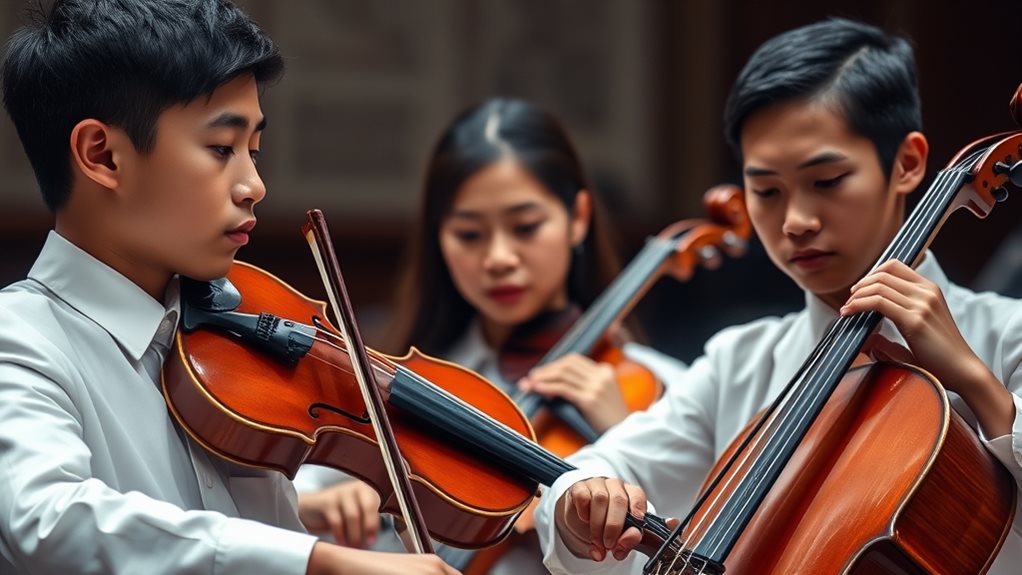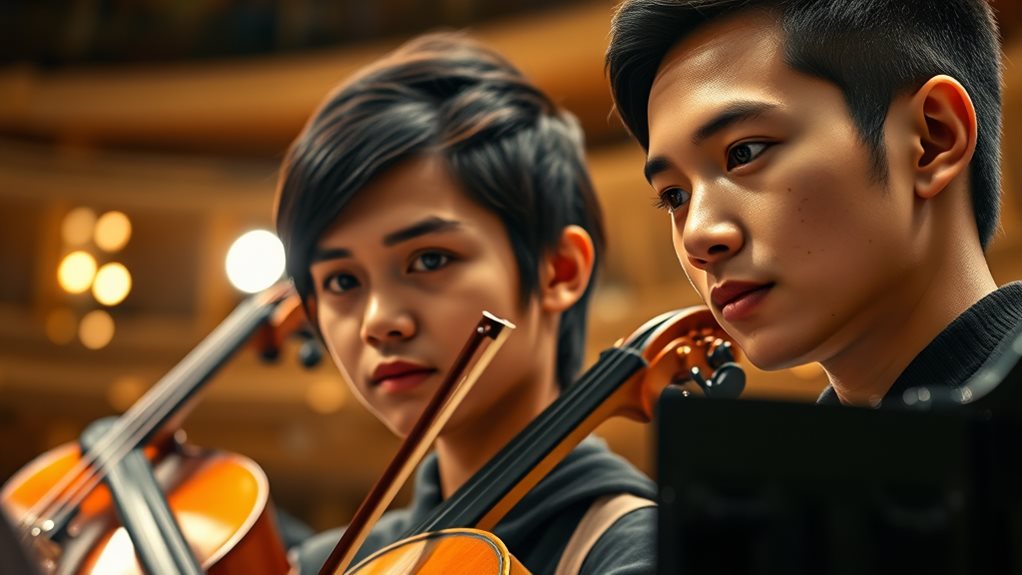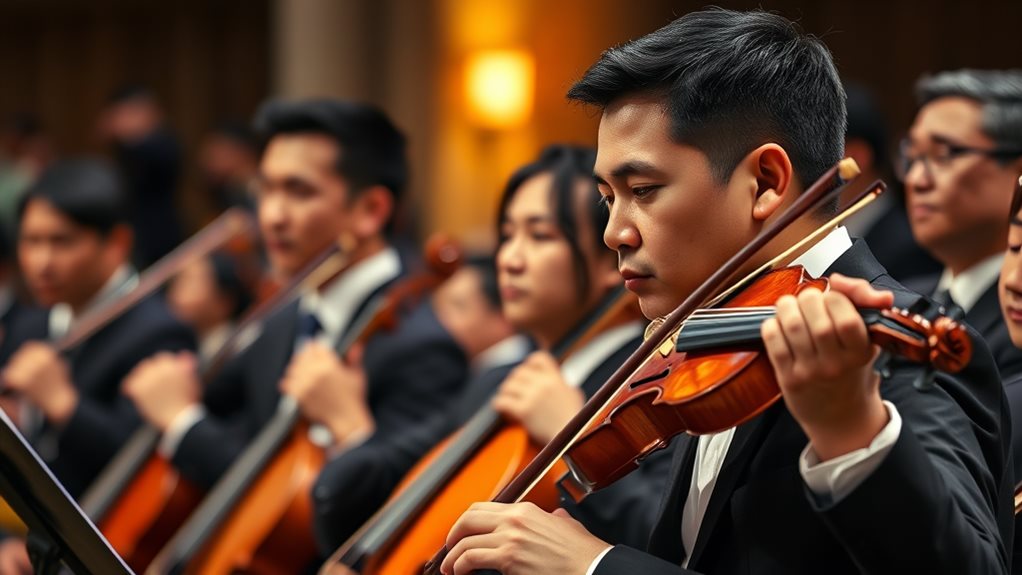The contemporary Filipino classical music scene is a thriving and innovative field that combines traditional and modern elements. Filipino composers like Ramon Santos and Francisco Feliciano are gaining international recognition for their unique blend of indigenous rhythms and Western techniques.
These composers draw from the country's rich musical heritage to create distinctive sounds. For example, Ramon Santos incorporates traditional Filipino instruments and melodies into his compositions. This blending of styles has resonated with global audiences and helped establish a distinctly Filipino voice in classical music.
In addition to individual composers, Filipino classical music ensembles are also achieving international success. The Manila Symphony Junior Orchestra has won several awards at prestigious competitions. This recognition highlights the talent and dedication of Filipino musicians and demonstrates the growing influence of Filipino classical music worldwide.
Leading Filipino Composers

The Philippines boasts a rich legacy of composers who've shaped the nation's musical identity.
Filipino composers have been contributing to the country's musical heritage since the early 20th century. Pioneer composers, such as Antonio Molina, often referred to as the "Claude Debussy of the Philippines," have made significant contributions.
The "Triumvirate" – Felipe de Leon, Francisco Santiago, and Lucrecia Kasilag**** – blended European styles with indigenous elements, creating a unique sound.
One notable composer, Lucrecia Kasilag, championed cultural fusion by incorporating traditional instruments into orchestral works.
Another composer, Ramon Santos, further advanced this fusion by blending chromaticism with Philippine sounds and electronic components.
Contemporary composers have continued this legacy.
Ryan Cayabyab, also known as "The Maestro," has made significant contributions to both contemporary and classical music.
Jose Maceda's expertise in ethnomusicology**** has profoundly influenced Philippine musical studies.
Other notable composers include Jonas Baes, known for experimenting with unusual instruments, and Miguel Velarde Jr., a pioneer of Philippine jazz.
The impact of Filipino composers extends beyond the Philippines.
Josefino Toledo's international acclaim highlights the growing recognition of Filipino artistry.
Jerry Dadap's performance at Carnegie Hall**** showcases the global reach of Filipino classical music.
Alfredo Buenaventura's accolades further demonstrate the impact of Filipino composers on the international stage.
Global Showcases of Talent
The Manila Symphony Junior Orchestra (MSJO) has achieved international success, showcasing Filipino musical talent on a global stage. The MSJO earned top honors at prestigious competitions, including a near-perfect score at the Bratislava International Music Festival and a first-place win at the Summa Cum Laude International Music Festival in Vienna.
These performances took place in renowned venues such as Vienna's Musikverein and Prague's Smetana Hall, featuring both Western classical pieces and uniquely Filipino compositions, which were entirely memorized.
Standard Insurance sponsored the MSJO's European tour, highlighting growing support for Filipino artistry**. This success isn't limited to classical music; it's also reflected in the global performances of Filipino pop artists**.
Cultural collaborations are becoming increasingly common, bridging musical boundaries. Filipino pop artists, such as SB19, Ben&Ben, and James Reid, have achieved international success through partnerships.
For example, Pink Sweat$ and Arthur Miguel's collaboration demonstrates the fusion of R&B and Filipino pop styles, gaining traction globally. Similarly, AJ Rafael and Tori Kelly's collaboration showcases the increasing popularity of Filipino artists.
Another notable example is No Rome and The 1975's collaboration, highlighting the success of indie pop and electronic genre blends.
These global performances and cultural collaborations contribute to the growing international recognition of Filipino musical talent. This recognition is a testament to the nation's rich cultural heritage and the artists' dedication.
Filipino music is transcending geographical boundaries, connecting with diverse audiences worldwide.
A Musical Renaissance

Contemporary Filipino classical music is undergoing a vibrant evolution, marked by a dynamic interplay between tradition and innovation. Filipino composers are seamlessly blending indigenous rhythms with modern compositions, creating unique soundscapes.
This blending of traditional and modern elements is evident in the use of traditional instruments, such as the kulintang, kudyapi, and banduria, in concert halls worldwide. These instruments, once confined to traditional settings, are now being used to create innovative scores.
The integration of old and new is also seen in the use of traditional time signatures, such as 2/4 and 4/4, in modern compositions. For example, Filipino composers are combining traditional melodies with European harmonies, as seen in Lucrecia Kasilag's "Fil-asiana."
This cultural fusion isn't limited to music alone. Filipino folklore and thematic references are enriching the narrative of contemporary compositions, showcasing a renewed appreciation for the aesthetic values inherent in Filipino music.
Filipino musicians are also engaging in international collaborations, influencing global musical trends and using music as a medium for storytelling and cultural exchange. Examples of this include collaborations between Filipino musicians and international artists, resulting in the creation of new and innovative sounds.
This musical renaissance is shaping the future of Filipino music, with a focus on preserving the past while creating new and innovative sounds. The result is a vibrant and diverse musical landscape, with Filipino musicians playing a significant role in shaping global musical trends.
Defining Filipino Classical Music
Filipino classical music is a unique blend of diverse influences**. Its roots can be found in the European art music tradition, spanning from the Baroque to Post-Romantic eras. However, centuries of Spanish and American influence have profoundly shaped its identity. Before colonization, local musical forms existed and contributed to the nation's cultural identity**.
The introduction of zarzuela and opera marked significant milestones in this musical evolution. These Western styles were integrated with local expressions, resulting in a distinct fusion of Western techniques with indigenous traditions. This fusion is evident in the works of composers who used Western musical idioms to express national events and identity. For example, the incorporation of folk elements in pieces like Abelardo's *Panoramas* and San Pedro's *Lahing Kayumanggi* showcase this blend.
Filipino classical music encompasses various forms, including sonatas, symphonies, concertos, operas, and zarzuelas. The kundiman, a genre of art songs infused with folk influences, is often considered a classical love song.
Semi-classical music, which includes stylized folk songs, hymns, and marches, further enriches the landscape. The influence of Western dance forms, such as the fandango, jota, and waltz, can be seen in secular music.
The popularity of opera and orchestral music among the educated elite reflects the musical evolution of the Philippines. The establishment of music conservatories solidified this cultural identity, training musicians and promoting the heritage.
International Acclaim

Ramon P. Santos and Francisco F. Feliciano are two Filipino composers who've gained international recognition for their award-winning compositions.
Ramon P. Santos' talent has reached a global audience through his work with various renowned orchestras. He has conducted the Moscow State Symphony Orchestra, Chicago Symphony Orchestra, and New Zealand Symphony Orchestra**. Additionally, Santos has led the Philippine Philharmonic Orchestra**, Japan Shensei Symphony Orchestra, and Korea National Orchestra, showcasing his mastery and elevating Filipino musical artistry on a global stage.
Francisco F. Feliciano's choral compositions, such as "Pokpok Alimpako" and "Pamugon," have garnered significant praise for their rhythmic vitality and intricate structure. His works, demanding technically, rival those of Western masters, placing Filipino music in the forefront of international discourse.
Feliciano's use of traditional kundiman in compositions like "Sisikat ang Araw" further demonstrates his sensitivity to Filipino musical heritage.
Both composers' works showcase a unique blend of Western and non-Western influences, resulting in a distinctive sound that resonates globally. Their innovative approaches and incorporation of indigenous instruments and vocal styles enrich the global music landscape.
The legacy of Santos and Feliciano isn't just in their award-winning compositions and global performances, but also in their propagation of a new musical language reflecting Filipino and Asian cultures.
Questions and Answers
What Instruments Are Commonly Used?
Traditional instruments commonly used include the kulintang and kutiyapi. In addition to these traditional instruments, modern adaptations of Western classical instruments are also frequently used, such as pianos, cellos, and violins.
How Is Filipino Music Taught?
Filipino music education combines traditional techniques with Western classical styles. This blend of cultural influences allows students to appreciate the country's rich musical heritage.
Specifically, the curriculum covers both Filipino and Western music forms. This dual approach aims to emphasize nationalistic ideals and provide historical context. For instance, students may learn about traditional Filipino instruments like the 'kulintang' or 'tambuli,' while also studying Western classical styles like opera or symphonic music.
Are There Famous Filipino Opera Singers?
Yes, famous Filipino opera singers exist. One prominent example is Evelyn Mandac, a renowned Filipino soprano known for her exceptional vocal techniques. Her notable performances showcase her exceptional skill and have left a lasting legacy in the world of opera.
What Are the Biggest Challenges Faced?
Balancing cultural identity with global competition is a significant challenge. This challenge arises because many organizations struggle to maintain their unique cultural identity while competing in a global market. For instance, a company may need to adapt its products or services to suit different cultural preferences, which can be difficult to balance with its core identity.
Limited international exposure hinders progress. One reason for this limited exposure is the lack of opportunities to showcase products or services on a global stage. For example, a small business may not have the resources to participate in international trade shows or conferences, making it harder to gain recognition and attract global customers.
Insufficient funding is a major obstacle. Many organizations lack the financial resources needed to invest in global marketing, research, and development. For example, a startup may not have the funds to hire a team of international marketers or conduct market research in different countries, limiting its ability to expand globally.
Global recognition remains elusive due to these challenges. As a result, many organizations struggle to gain recognition and establish a strong reputation in the global market. For instance, a company may have a strong reputation in its local market, but it may be unknown in other parts of the world, making it harder to attract global customers and partners.
How Is Funding Secured for Musicians?
Musicians secure funding through various avenues. Funding opportunities for musicians include government grants, sponsorship deals, crowdfunding campaigns, and international foundations.
Government grants, such as the National Endowment for the Arts, provide financial support for musicians to pursue their artistic projects. Sponsorship deals with private entities, like instrument manufacturers or music streaming services, can also be a viable option.
Crowdfunding campaigns allow musicians to raise funds from a large number of people, typically through online platforms like Kickstarter or Patreon. International foundations, such as the International Music Managers Forum, offer funding and resources to support musicians in their careers.